WIPP News
Open the accordions below to view news, recent information and links to historical WIPP compliance and rulemaking activities. View Certification and Recertification of WIPP information. Updates and information related to the Waste Isolation Pilot Plant (WIPP) will be posted to this page as it is available.
- Informal Stakeholder Webinar – 2014 WIPP CRA (Completeness Determination)
The EPA will be hosting an informal webinar session for the public to provide comments and ask questions regarding the 2014 WIPP CRA – specifically concerning the upcoming completeness determination on the application. The Agency has reserved hosting locations in both Carlsbad and Albuquerque for interested stakeholders to attend in New Mexico. The webinar will be held jointly (with both locations patched in via Adobe Connect) on Thursday, January 12th, from 1:00 - 4:00 PM (MST):
New Mexico State University - Carlsbad
Room 201
1500 University Drive
Carlsbad, NM 88220University of New Mexico - Albuquerque
Student Union Building Fiesta A & B
1 University of New Mexico
Albuquerque, NM 87131-0001For any members of the public that are unable to attend the hosting locations, you may also participate remotely via Adobe Connect and conference line with the following details:
http://epawebconferencing.acms.com/wipp
Conference #: 1-866-299-3188
Conference code: 2023439201#
- WIPP Interim Ventilation System (IVS) Approval
The U.S. Environmental Protection Agency (EPA) has completed its review of work undertaken by the Department of Energy (DOE) to qualify Station B for sampling facility exhaust from the Waste Isolation Pilot Plant (WIPP). Based on information supplied by DOE and a subsequent EPA inspection held on April 26-27, 2016, the Agency finds that with the Interim Ventilation System (IVS) added to the existing Underground Ventilation and Filtration System (UVFS), air samples taken at Station B will continue to accurately represent facility exhaust for the purposes of compliance with the public dose limits found at 40 CFR part 191, Subpart A and 40 CFR part 61, Subpart H.
View correspondence between EPA and DOE regarding the interim and supplemental ventilation systems, as well as the inspection report from April 2016, on the WIPP Interim Ventilation System (IVS) Approval Documents page.
- Biennial Environmental Compliance Report (2012 - 2014)
Section 9 of The Waste Isolation Pilot Plant (WIPP) Land Withdrawal Act (LWA) (PDF) (7 pp, 159.32 K, About PDF) specifies that every two years the U.S. Department of Energy (DOE) must demonstrate that the WIPP facility complies with applicable federal laws pertaining to public health and safety of the environment, including the regulations and permit requirements under such laws. This report is submitted to the U.S. Environmental Protection Agency (EPA) as the Biennial Environmental Compliance Report (BECR). Under the WIPP LWA, EPA is mandated to review the information and determine compliance or non-compliance during the reporting period.
Due to the February, 2014 radiological incident at the WIPP, it has taken time to receive complete documentation needed for an environmental compliance determination. The Agency’s Regional Administrator in Region 6 sent an interim response to DOE in April, 2015 requesting the required information. As outlined in EPA’s June 3, 2016 letter to the Secretary of Energy, the Agency has been able to conclude its review of the WIPP BECR for the reporting period, April 1, 2012 through March 31, 2014 based on receipt of all cumulative documentation from DOE and the Settlement Agreement between the State of New Mexico and the Department. EPA will consider DOE’s compliance with the Settlement Agreement as part of its review for the next BECR reporting period, from April 1, 2014 to March 31, 2016, and subsequent reporting periods as appropriate. The Agency will continue its oversight of the WIPP and continue to work cooperatively with DOE, the State of New Mexico and the public to ensure that the WIPP is protective of human health and the environment.
View the Biennial Environmental Compliance Report (2012 - 2014) and related correspondence.
- Radiological Event at the WIPP (February 2014)
EPA Response to 2014 Radioactive Release at the Waste Isolation Pilot Plant (WIPP)
EPA is in regular contact with DOE, the New Mexico Environment Department and the Carlsbad Environmental Monitoring and Research Center. EPA’s review of the data collected indicates that:
- The radiation releases do not pose a public health concern.
- DOE followed the procedures previously approved by EPA.
- The WIPP facility remains in compliance with EPA regulations.
April 24, 2015: DOE released its Phase I Accident Investigation Report and accompanying summary slides regarding the WIPP event. View DOE's Phase I Accident Investigation Report.
March 30, 2015: DOE issued its Technical Assessment Team (TAT) Report related to the February 2014 radiological release at the WIPP. The TAT is an independent team of technical experts that evaluated the mechanisms and chemical reactions contributing to the failure of the waste drum in the underground facility. The report concludes that one drum (Drum 68660) was the source of radioactive contamination.
View DOE’s WIPP TAT Report released by the Office of Environmental Management.
December 7, 2014: DOE has responded to EPA’s WIPP Inspection Report and WIPP Summary Report (sent in October 2014), which documents the Agency’s actions and findings related to the February 2014 release at the facility. The report below includes a schedule and description of implemented and planned activities, as well as identifying improvements to the design and maintenance of the ambient air sampling network and integration of sample handling and analysis.
October 7, 2014: EPA has completed the April 2014 WIPP Inspection Report and the WIPP Summary Report documenting EPA’s actions and findings related to the February 14th release at WIPP. EPA found that the release was largely contained within the WIPP underground and the release did not pose a public health or environmental hazard. The public doses were well below EPA’s standards. EPA identified a number of areas needing improvement regarding DOE’s ambient environmental air sampling network, laboratory procedures and incident response protocols.
- Subpart A Inspection Report in Response to the February 14, 2014 WIPP Incident.
- Summary of EPA’s Response and Findings Related to the February 2014 Radioactive Release at the Waste Isolation Pilot Plant.
August 27, 2014: EPA evaluated DOE's dose projections and conducted independent public dose modeling using data supplied by DOE. DOE followed their modeling procedures and both DOE's and EPA's independent dose calculations resulted in the same effective dose equivalent of less than 1 mrem/year, well below the regulatory limit of 10 mrem/year.
- Consequence Assessment Review Summary for the February 2014 Radiological Emission Release at the Waste Isolation Pilot Plant.
- Environmental Protection Agency's Confirmatory Dose Calculations of the Department of Energy's Use of CAP88-PC for the February 2014 Radiological Emission Release at the Waste Isolation Pilot Plant.
- Quality Assurance Project Plan: Environmental Protection Agency’s Verification of the Department of Energy’s CAP88-PC WIPP Release Dose Calculations.
August 13, 2014: EPA completed an evaluation of DOE's WIPP Laboratories americium and plutonium results from air samples collected at the WIPP site in February and March 2014. The verification identified a number of deviations from stated requirements or expectations. EPA's review of the calculations also identified apparent flaws in how results are calculated. The calculation errors should have minimal impact on the usability of the data that were reviewed. DOE needs to address these findings in order to provide the most defensible data possible at all times.
August 8, 2014: EPA completed a statistical analysis comparing EPA and DOE air filter results collected during three weeks in April 2014. EPA found that the EPA and DOE results were consistent:
- There was no evidence of a systematic difference between the DOE and EPA activity concentration measurements.
- For both DOE and EPA data, the variation observed among the activity concentration measurements was consistent with the measured uncertainty.
- There was no evidence of positive concentrations for any of the monitored radionuclides.
Additional supporting documents:
- Analysis of EPA and DOE WIPP Air Sampling Data.
- NAREL Quality Assurance Project Plan: Deployment of Air Monitors to the WIPP Site.
June 11, 2014: EPA published a report on the April 9, 2014 visit to the Waste Control Specialists. EPA determined that the system of controls in place adequately tracks waste containers in storage and appropriately maintains waste inventory records.
June 6, 2014: EPA completed the analysis of the air filters collected by our team at WIPP in April 2014. All the results were considered "non-detect" for americium-241, plutonium-238 and plutonium-239/240; these are the radionuclides of concern with a release at the WIPP site. “Non-detect” means that no radioactivity was detected or measurable beyond the analytical uncertainty range. To date, EPA's review of the data collected indicates that the radiation releases did not pose a public health concern.
May 1, 2014: On April 9, 2014, EPA’s WIPP waste characterization team visited Waste Control Specialists (WCS) to determine whether the Department of Energy (DOE) was meeting EPA’s waste inventory tracking requirements. DOE began shipping waste to the Andrews, Texas-based WCS in April 2014 due to the temporary closure of WIPP. Under the State of New Mexico Governor’s Directive, DOE must remove 3,706 cubic meters of transuranic waste from Los Alamos National Laboratory by June 30, 2014. During the WCS visit, EPA observed unloading and storage operations, interviewed WCS and DOE Contractor staff and evaluated objective evidence for technical adequacy. EPA determined that the system of controls in place adequately tracks waste containers in storage and appropriately maintains waste inventory records.
April 25, 2014: On Thursday, April 24, 2014, members of the EPA’s WIPP team attended and presented at the Carlsbad Town hall meeting.
April 17, 2014: On Wednesday, April 16, 2014, the EPA WIPP Team performed an operational check on its four air samplers at the facility and also met with DOE representatives on the Agency's continuing monitoring activities. Additional air sampling and shipping equipment was left at the site for future filter replacements.
April 16, 2014: On Tuesday, April 15, 2014, the EPA WIPP Team performed the first of three filter change-outs for its four air samplers (co-located alongside DOE's samplers) at the facility. After being checked and verified, the four samples (plus a blank filter) were packaged and shipped to the EPA's National Analytical Radiation Environmental Laboratory (NAREL) for analysis. EPA staff were also given a tour of the New Mexico Environment Department's solar-powered monitor in Mobley Ranch near the WIPP site.
April 15, 2014: On Monday, April 14, 2014, the EPA WIPP team met with DOE staff and toured the facility's radioanalytical laboratory. The Agency also met with WIPP Environmental Group representatives to relocate air sampling, air filter and shipping supplies onsite at the WIPP for continued monitoring. Finally, the WIPP team attended and presented at the Council meeting in Jal, New Mexico.
April 14, 2014: On Friday, April 11, 2014, EPA's WIPP team toured the WIPP Waste Handling Facility alongside DOE staff. The Agency's field team also met with the environmental sampling and radiation control groups to ensure continued coordination in all ongoing activities.
April 11, 2014: On April 10, 2014, EPA's WIPP assessment and monitoring team met with DOE WIPP laboratory personnel and observed laboratory operations. Members of the EPA WIPP team also attended and presented at the Carlsbad Town hall meeting.
April 9, 2014: Since arriving at WIPP on Monday, members of EPA’s environmental monitoring and assessment team completed an initial review of the operations of DOE’s air samplers and placed EPA air samplers at three sites near existing DOE samplers.
April 7, 2014: Members of EPA’s environmental monitoring and assessment team are arriving at WIPP today. This site visit will support EPA’s larger, long-term evaluation of WIPP’s continued compliance with the requirements of 40 CFR Part 191, Subpart A.
While at the WIPP facility, EPA will:- Review DOE’s air sampling plan for monitoring the area in and around the facility.
- Visit DOE’s air samplers to review their operations.
- Place a limited number of air samplers on-site near existing DOE samplers to independently corroborate DOE’s reported results.
March 26, 2014: EPA has been in daily contact with the New Mexico Environment Department (NMED) in actively overseeing the actions being taken by the Department of Energy (DOE) related to the February 2014 radiological event at the WIPP. Based on the available information, the Agency does not believe that the radioactive releases from the WIPP present public health concerns or regulatory compliance issues. As DOE plans to enter the facility, EPA will deploy several air samplers to validate and verify DOE monitoring. The Agency will continue to communicate regularly with DOE and the NMED, and will share information with the public on EPA’s oversight actions at the WIPP facility through this website and other mechanisms. View EPA's one-page summary of the response and actions related to the WIPP event, EPA Actions in Response to Release of Radioactive Material from the Waste Isolation Pilot Plant (WIPP).
March 5, 2014: EPA has responded to several Congressional inquiries for information about the radiological event at the WIPP.
- Response to U.S. Senator Tom Udall on Radiological Event at the WIPP.
- Request for Assistance and Information on Radiological Event at the WIPP from the U.S. Senate.
- Response to Senator Martin Heinrich on Radiological Event at WIPP.
WIPP Response Photo Gallery
< Previous Next >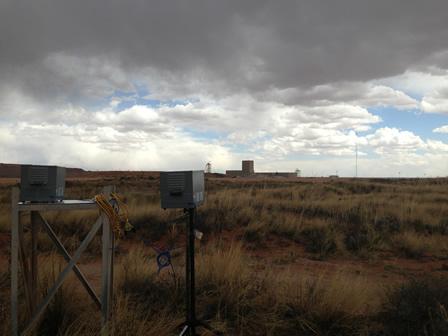 April 7, 2014: EPA staff set up air samplers near the Waste Isolation Pilot Plant. The results from the air filter analyses will help independently corroborate Department of Energy's results. (Image 1)
April 7, 2014: EPA staff set up air samplers near the Waste Isolation Pilot Plant. The results from the air filter analyses will help independently corroborate Department of Energy's results. (Image 1)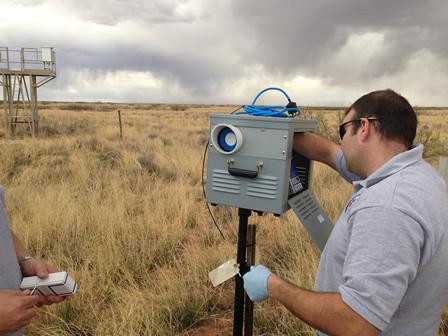 April 7, 2014: EPA staff set up air samplers near the Waste Isolation Pilot Plant. The results from the air filter analyses will help independently corroborate Department of Energy's results. (Image 2)
April 7, 2014: EPA staff set up air samplers near the Waste Isolation Pilot Plant. The results from the air filter analyses will help independently corroborate Department of Energy's results. (Image 2)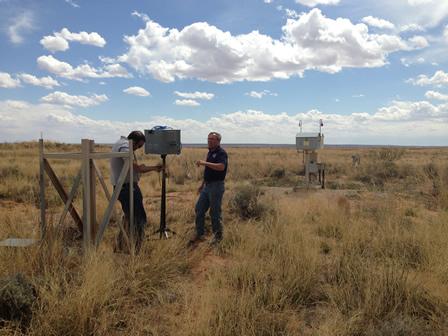 April 7, 2014: EPA staff set up air samplers near the Waste Isolation Pilot Plant. The results from the air filter analyses will help independently corroborate Department of Energy's results. (Image 3)
April 7, 2014: EPA staff set up air samplers near the Waste Isolation Pilot Plant. The results from the air filter analyses will help independently corroborate Department of Energy's results. (Image 3)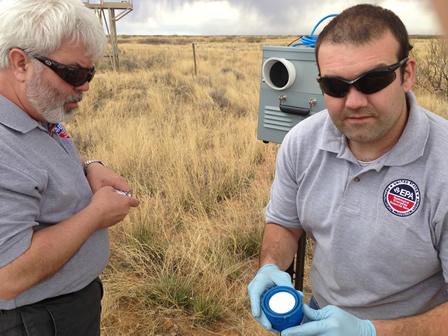 April 7, 2014: EPA staff set up air samplers near the Waste Isolation Pilot Plant. The results from the air filter analyses will help independently corroborate Department of Energy's results. (Image 4)
April 7, 2014: EPA staff set up air samplers near the Waste Isolation Pilot Plant. The results from the air filter analyses will help independently corroborate Department of Energy's results. (Image 4)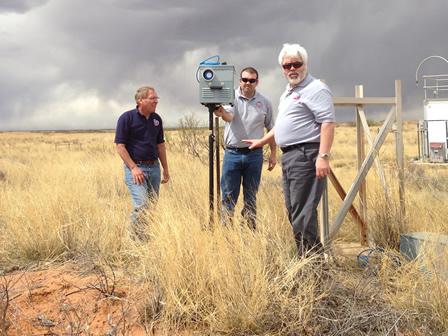 April 7, 2014: EPA staff set up air samplers near the Waste Isolation Pilot Plant. The results from the air filter analyses will help independently corroborate Department of Energy's results. (Image 5)
April 7, 2014: EPA staff set up air samplers near the Waste Isolation Pilot Plant. The results from the air filter analyses will help independently corroborate Department of Energy's results. (Image 5)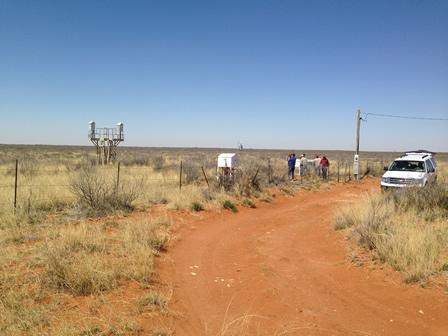 April 8, 2014: EPA's WIPP team visits Department of Energy's low-volume air samplers as part of their initial review of DOE's air sampling plans. (Image 1)
April 8, 2014: EPA's WIPP team visits Department of Energy's low-volume air samplers as part of their initial review of DOE's air sampling plans. (Image 1)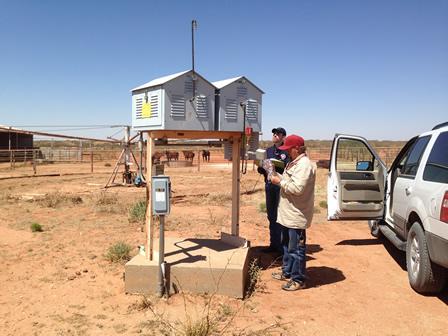 April 8, 2014: EPA's WIPP team visits Department of Energy's low-volume air samplers as part of their initial review of DOE's air sampling plans. (Image 2)
April 8, 2014: EPA's WIPP team visits Department of Energy's low-volume air samplers as part of their initial review of DOE's air sampling plans. (Image 2)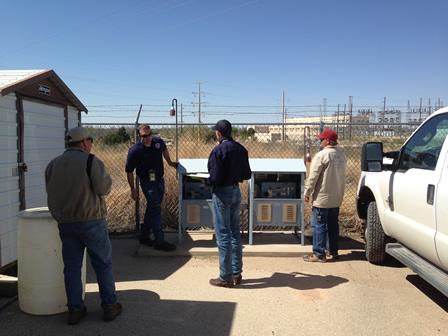 April 8, 2014: EPA's WIPP team visits Department of Energy's low-volume air samplers as part of their initial review of DOE's air sampling plans. (Image 3)
April 8, 2014: EPA's WIPP team visits Department of Energy's low-volume air samplers as part of their initial review of DOE's air sampling plans. (Image 3)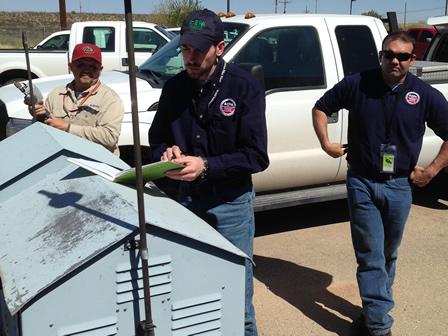 April 8, 2014: EPA's WIPP team visits Department of Energy's low-volume air samplers as part of their initial review of DOE's air sampling plans. (Image 4)
April 8, 2014: EPA's WIPP team visits Department of Energy's low-volume air samplers as part of their initial review of DOE's air sampling plans. (Image 4)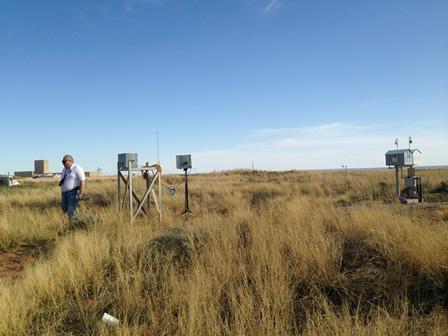 April 9, 2014: EPA air samplers (boxes on stands) and DOE air samplers (that look like little houses) are collocated at sites near WIPP. EPA staff view the WIPP salt shaft. (Image 1)
April 9, 2014: EPA air samplers (boxes on stands) and DOE air samplers (that look like little houses) are collocated at sites near WIPP. EPA staff view the WIPP salt shaft. (Image 1)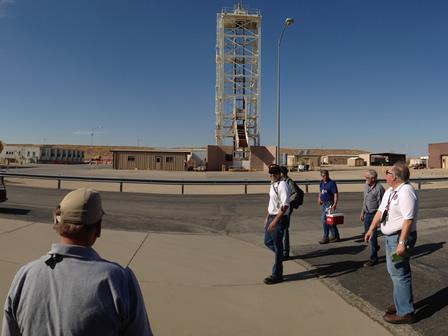 April 9, 2014: EPA air samplers (boxes on stands) and DOE air samplers (that look like little houses) are collocated at sites near WIPP. EPA staff view the WIPP salt shaft. (Image 2)
April 9, 2014: EPA air samplers (boxes on stands) and DOE air samplers (that look like little houses) are collocated at sites near WIPP. EPA staff view the WIPP salt shaft. (Image 2)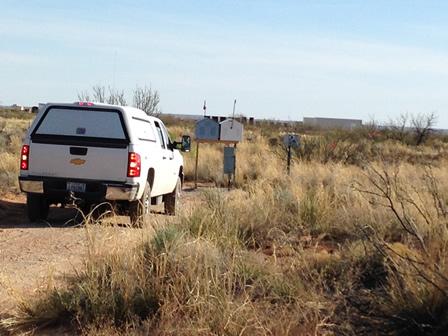 April 9, 2014: EPA air samplers (boxes on stands) and DOE air samplers (that look like little houses) are collocated at sites near WIPP. EPA staff view the WIPP salt shaft. (Image 3)
April 9, 2014: EPA air samplers (boxes on stands) and DOE air samplers (that look like little houses) are collocated at sites near WIPP. EPA staff view the WIPP salt shaft. (Image 3) April 10, 2014: EPA staff meet with DOE staff at the WIPP laboratory. EPA WIPP team attend and present at the Carlsbad Town hall meeting. (Image 1)
April 10, 2014: EPA staff meet with DOE staff at the WIPP laboratory. EPA WIPP team attend and present at the Carlsbad Town hall meeting. (Image 1)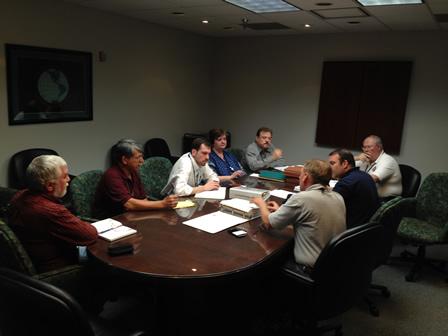 April 10, 2014: EPA staff meet with DOE staff at the WIPP laboratory. EPA WIPP team attend and present at the Carlsbad Town hall meeting. (Image 2)
April 10, 2014: EPA staff meet with DOE staff at the WIPP laboratory. EPA WIPP team attend and present at the Carlsbad Town hall meeting. (Image 2)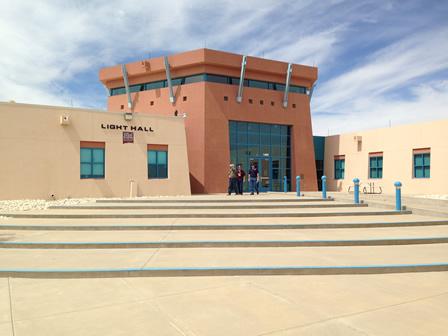 April 10, 2014: EPA staff meet with DOE staff at the WIPP laboratory. EPA WIPP team attend and present at the Carlsbad Town hall meeting. (Image 3)
April 10, 2014: EPA staff meet with DOE staff at the WIPP laboratory. EPA WIPP team attend and present at the Carlsbad Town hall meeting. (Image 3)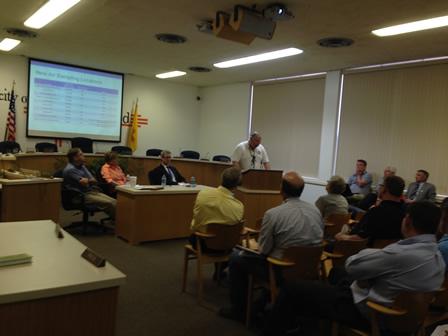 April 10, 2014: EPA staff meet with DOE staff at the WIPP laboratory. EPA WIPP team attend and present at the Carlsbad Town hall meeting. (Image 4)
April 10, 2014: EPA staff meet with DOE staff at the WIPP laboratory. EPA WIPP team attend and present at the Carlsbad Town hall meeting. (Image 4)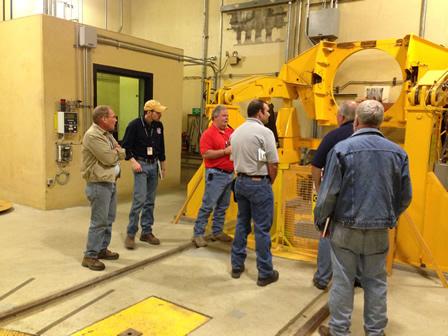 April 11, 2014: EPA's WIPP team tours the WIPP Waste Handling Facility with DOE staff. (Image 1)
April 11, 2014: EPA's WIPP team tours the WIPP Waste Handling Facility with DOE staff. (Image 1)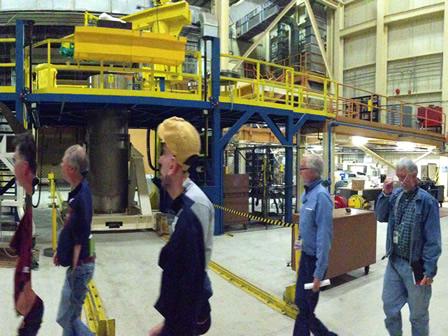 April 11, 2014: EPA's WIPP team tours the WIPP Waste Handling Facility with DOE staff. (Image 2)
April 11, 2014: EPA's WIPP team tours the WIPP Waste Handling Facility with DOE staff. (Image 2)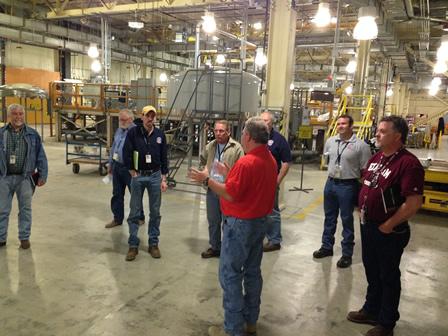 April 11, 2014: EPA's WIPP team tours the WIPP Waste Handling Facility with DOE staff. (Image 3)
April 11, 2014: EPA's WIPP team tours the WIPP Waste Handling Facility with DOE staff. (Image 3)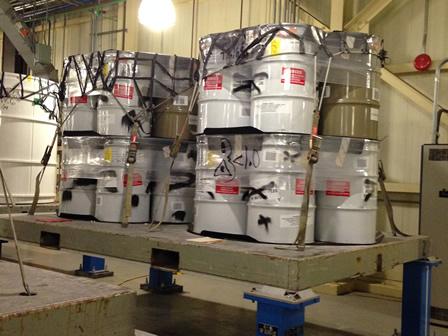 April 11, 2014: EPA's WIPP team tours the WIPP Waste Handling Facility with DOE staff. (Image 4)
April 11, 2014: EPA's WIPP team tours the WIPP Waste Handling Facility with DOE staff. (Image 4)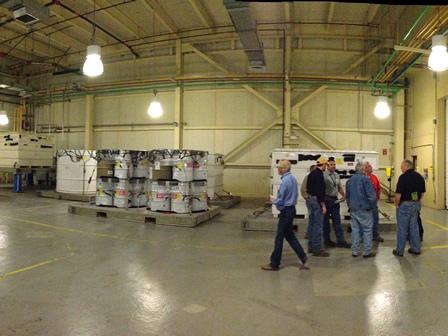 April 11, 2014: EPA's WIPP team tours the WIPP Waste Handling Facility with DOE staff. (Image 5)
April 11, 2014: EPA's WIPP team tours the WIPP Waste Handling Facility with DOE staff. (Image 5)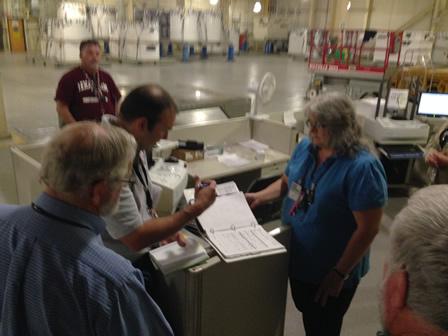 April 11, 2014: EPA's WIPP team tours the WIPP Waste Handling Facility with DOE staff. (Image 6)
April 11, 2014: EPA's WIPP team tours the WIPP Waste Handling Facility with DOE staff. (Image 6)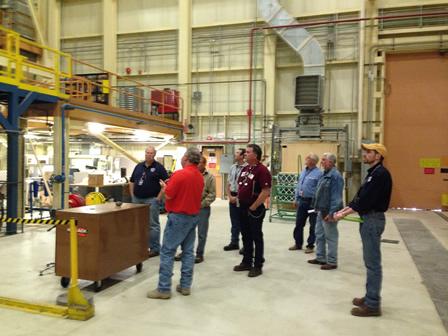 April 11, 2014: EPA's WIPP team tours the WIPP Waste Handling Facility with DOE staff. (Image 7)
April 11, 2014: EPA's WIPP team tours the WIPP Waste Handling Facility with DOE staff. (Image 7)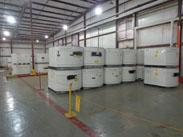 May 1, 2014: At the beginning of April, EPA staff visited the Waste Control Specialist facility in Texas, which is storing transuranic waste during the temporary closure of WIPP.
May 1, 2014: At the beginning of April, EPA staff visited the Waste Control Specialist facility in Texas, which is storing transuranic waste during the temporary closure of WIPP.EPA’s Role at WIPP
EPA’s primary role at the WIPP is to certify Department of Energy (DOE) compliance with public radiation dose and ground water protection standards (40 CFR Part 194; Subparts B and C of 40 CFR Part 191). EPA determines if DOE is in compliance by conducting regular inspections of the WIPP facility and by reviewing DOE documents and operation plans. EPA also has a limited role in implementing Subpart A of 40 CFR Part 191, Management and Storage, which has public dose limits during facility operations.
Learn more about EPA’s oversight role at WIPP.
Links to related information:
- U.S. Department of Energy, Waste Isolation Pilot Plant Recovery – This site provides information about DOE’s WIPP facility and its response to two isolated events took place at WIPP in February, a fire involving a salt haul truck and an alarm from a continuous air monitor (CAM) during the night shift.
- New Mexico Environment Department- Waste Isolation Pilot Plant Issue Page – This site describes NMED’s response to the February 2014 Underground Salt Truck Fire and Radionuclide Release Events.
- Carlsbad Environmental Monitoring & Research Center – This site provides links to the WIPP air sampling results taken by the Carlsbad Environmental Monitoring & Research Center.
- Panel Closure Redesign Planned Change Request – Final Rule (September 2014)
On September 30, 2014, EPA’s Acting Assistant Administrator for the Office of Air and Radiation, Janet McCabe, signed the final rule approving the U.S. Department of Energy’s (DOE’s) planned change request to implement the Run-of-Mine Salt Panel Closure System (ROMPCS) at the WIPP. This final action modifies a small portion of the WIPP Compliance Criteria (40 CFR Part 194, Appendix A, Condition 1). Rather than installing concrete monoliths and mortared explosion walls (the previously required Option D design), this newly approved panel closure system will make use of mined salt backfill and steel bulkheads to permanently seal waste panels in the repository.
All previous news and information updates related to the planned change request can be found below.
________________________
On December 3, 2013, the EPA published a Federal Register Notice proposing to approve the U.S. Department of Energy’s (DOE’s) planned change request to implement the Run-of-Mine Salt Panel Closure System (ROMPCS) at the WIPP. The proposed action will modify a small portion of 40 CFR Part 194 (the WIPP Compliance Criteria), Appendix A, Condition 1, to allow an EPA-approved panel closure other than the currently-required Option D design. Rather than utilizing Option D – which requires the installation of concrete monoliths and mortared explosion walls – the new design will make use of mined salt backfill and steel bulkheads to seal waste panels in the repository.
The Agency verified the DOE-provided technical analyses demonstrating that the WIPP containment requirements of 40 CFR Part 191.13 continue to be met with the modified panel closure design. These limits ensure the isolation of transuranic waste from the accessible environment over the 10,000-year regulatory period. The proposed changes reduce costs and impacts on current and future waste emplacement activities. However, they do not lessen the requirements for complying with the Compliance Criteria, nor do these changes impact the technical approach that the EPA will employ when considering any future planned changes to the panel closure system.
The FR notice announcing the proposed rule and accompanying supplemental information can be found in the Agency's official docket, EPA-HQ-OAR-2013-0684. The 60-day comment period closed on February 3, 2014.
The EPA held two public meeting sessions in New Mexico related to the Agency's recent proposed rule regarding DOE's panel closure redesign planned change request. With the formal public formal comment period still underway, the purpose of these meetings was to gather comments from members of the public on the proposed rulemaking and to provide a facilitated forum for clarifying questions. Staff from the U.S. Department of Energy (DOE) and the New Mexico Environment Department (NMED) were in attendance. The details for the meetings were as follows:
Wednesday, January 22, 2014 - Carlsbad, New Mexico
U.S. Department of Energy, Carlsbad Field Office
Skeen-Whitlock Building, Main Auditorium
4021 National Parks Highway
1:00 PM - 4:00 PMThursday, January 23, 2014 - Albuquerque, New Mexico
Albuquerque Embassy Suites Hotel & Spa, Sandia Ballroom VI-VIII
1000 Woodward Place NE
Albuquerque, NM 8710
1:00 PM - 4:00 PMThere were also two informal public meetings held in Carlsbad and Albuquerque, NM in 2012 to get preliminary comments and input from members of the public in advance of the rulemaking and its associated public meetings. Staff from the U.S. Department of Energy (DOE) and the New Mexico Environment Department (NMED) were on hand to answer any stakeholder questions/concerns. The logistics for both meetings in Carlsbad and Santa Fe were as follows:
Wednesday, December 5, 2012 - Carlsbad, New Mexico
U.S. Department of Energy, Carlsbad Field Office
Skeen-Whitlock Building, Main Auditorium
4021 National Parks Highway
9:30 AM – 1:00 PMThursday, December 6, 2012 - Santa Fe, New Mexico
New Mexico Environment Department, Harold L. Runnels Building, Auditorium
1190 St. Francis Drive
9:30 AM - 1:00 PMView meeting notes from all four meetings in the official Docket, EPA-HQ-OAR-2013-0684.
________________________
On September 28, 2011, the U.S. Department of Energy (DOE) provided a planned change request for panel closure redesign, which would modify Condition 1 of the Final WIPP Certification Decision for 40 CFR Part 194.
After 12 years of operating experience, DOE has acquired considerable experience and knowledge regarding the behavior of the WIPP repository, along with the nature and behavior of disposed transuranic (TRU) waste. In EPA's 1998 WIPP Certification Decision, the Agency listed a number of conditions - one of which was that the panel closure system (PCS) to be used in WIPP be "Option D," as specified in DOE's Compliance Certification Application (CCA). This option specified that certain components be constructed using Salado Mass Concrete (SMC).
After numerous large scale tests, DOE states that SMC cannot meet the design and performance requirements for the panel closures as specified in the CCA. Since results from monitoring for explosive gases in the closed panels has established that the measured concentrations of methane and hydrogen will remain below the lower limits through the operational period, the Department has submitted a new panel closure design - the Run-of Mine Panel Closure (ROMPC).
The Department submitted a performance assessment (PA) for the proposed panel closure redesign as part of their documentation package. The results of the PA show that WIPP will remain in compliance with all disposal requirements 40 CFR Part 191, Subparts B and C, and essentially have the same performance as the original Option D design.
The EPA sent the DOE a series of comments related to the initial proposal, and the Department has responded with supplemental information on the panel closure redesign and associated performance assessment (PCS-2012 PA).
- Shielded Containers (2007 - 2013)
The EPA has determined that the DOE has met the Agency's previous condition placed on the use of shielded containers for remote-handled (RH) transuranic (TRU) waste destined for disposal at WIPP. The Department is now authorized to ship waste only from approved waste streams using the shielded container assembly (SCA) and complex-wide procedures/processes associated with the SCA.
This approval comes after a thorough technical review of information submitted by the DOE, as well as comments submitted by interested stakeholders.
________________________
The DOE has submitted additional information related to shielded containers and complex-wide procedures that will be implemented by CCP to ensure that the surface dose rate from the containers is below the RH-waste limit of 200 millirem/hour. The DOE's letter also references an April 2013 EPA email regarding dose measurement uncertainty, which has been provided below:
- Letter from DOE to EPA regarding requested procedural changes related to shielded containers at WIPP
- Internal EPA email regarding DOE dose contact measurement
August 5, 2013 DOE Submission
_________________________
EPA issued its final technical decision regarding the U.S Department of Energy's (DOE's) shielded containers planned change request. The DOE originally submitted this request on November 15, 2007, which is documented in the accompanying information below. Since that time, the Department has submitted supplemental information related to the shielded containers, most recently on December 3, 2010. This information includes all of the stakeholder concerns brought up during the public meetings held in November 2007, as well as input received during our initial informal comment period, which closed in January 2008.
The Agency opened an additional informal comment period on the shielded containers proposed decision. The comment period was originally scheduled to close after 60 days on on May 24, 2011. However, after requests from the public, the EPA extended it for another 30 days. The second informal comment period for this proposed decision closed on June 23, 2011.
At this time, EPA approved the emplacement of shielded container assemblies at WIPP as outlined below in the letter and attachment (response to comments) - with one condition. Prior to shipping shielded containers to WIPP, the DOE must demonstrate a consistent complex-wide procedure to ensure that the shielded containers containing RH waste remain below the Land Withdrawal Act surface dose rate limit for CH waste of 200 millirem per hour. The procedure will be evaluated for technical adequacy as part of the Agency’s waste characterization inspection and approval process. Please note that no shielded containers may be shipped to WIPP from any RH TRU site until the EPA inspects and approves the implemented procedure. In addition, the DOE will need a separate hazardous waste permit modification from the New Mexico Environment Department to use the SCA; this approval is independent of that permit modification.
__________________________
- Letter from EPA to the DOE Carlsbad Office notifying DOE of EPA's approval of DOE's planned change request regarding the handling of RH TRU at the WIPP
- Review of DOE Planned Change Request for Shielded Containers for Remote-Handled Transuranic Waste
__________________________
On November 15, 2007, the U.S. Department of Energy (DOE) submitted a planned change request proposing to package and emplace a portion of the Remote Handled (RH) Transuranic (TRU) Waste Inventory in shielded containers at the WIPP.
Documentation related to this change request is available below, including a fact sheet that provides the background and history of the issue, a summary of the proposed change and DOE’s rationale and the projected impact on WIPP performance.
On December 7, 2007, and April 15, 2008, the EPA submitted comments to the DOE regarding their Shielded Containers planned change request.
- Memo from EPA to DOE regarding a preparatory review of DOE RH shielded container planned change request (12/7/2007)
- Letter from EPA to DOE regarding the review of DOE's submittal for a change request (4/15/2008)
EPA opened an unofficial 60-day public comment period, which closed on January 29, 2008.
DOE submitted supplemental information related to their shielded containers planned change request.
October 29, 2008 DOE Submission
On December 11, 2008, the EPA responded with additional comments regarding the DOE's submissions:
January 21, 2009 DOE Submission:
June 10, 2009 DOE Submission:
August 27, 2009 DOE Submission:
June 11, 2010 Submission:
September 8, 2010 DOE Submission:
November 10, 2010 DOE Submission
December 3, 2010 DOE Submission:
- Biennial Environmental Compliance Report (2010 - 2012)
Section 9 of the 1992 WIPP Land Withdrawal Act (LWA) specifies that every two years the DOE must demonstrate that the WIPP facility complies with applicable Federal laws pertaining to public health and safety of the environment, including the regulations and permit requirements under such laws. This report is submitted to the EPA as the Biennial Environmental Compliance Report (BECR). Under the WIPP LWA, EPA is mandated to review the information and determine compliance or non-compliance during the reporting period.
After thorough review, the EPA has concluded that, for the reporting period of April 1, 2010, through March 31, 2012, the WIPP has remained in compliance with applicable environmental Federal laws and regulations.
View the Biennial Environmental Compliance Report (2010 - 2012) and related correspondence.
EPA anticipates to receive the 2012 - 2014 BECR from DOE in late Fall 2014 and will make a determination sometime in 2015.
- Drum Accidentally Punctured in the WIPP Repository (June 2012)
On June 19, 2012, during normal waste emplacement activities in the underground at the Waste Isolation Pilot Plant (WIPP) involving contact-handled Waste Handling Operations (WHO) personnel, a forklift attachment breached an emplaced waste drum. A forklift operator had approached the waste face with a waste package loaded on the forklift and proceeded to align the forklift with a waste stack column. A WHO spotter was in position and signaled the forklift operator to stop but there was a delay in reaction time between the spotter's signal and the forklift operator's response. The breach was approximately 2 to 3 inches in length and approximately 7 inches from the bottom of the drum. The forklift operator moved the loaded forklift approximately 8 feet away from the waste face and lowered the payload to the ground.
The Facility Shift Manager was notified and personnel in the immediate area were directed to leave through the intake air travel path. Radiological monitoring for personnel in the immediate work area did not reveal any contamination on any of the workers involved. In addition, radiological air monitoring equipment for the affected work area did not alarm or indicate any detection of contamination. Within hours of the event, the Facility Manager directed the development of a work control document, for re-entry into the area and to seal the damaged drum. Surveys of the drum, area, and equipment were conducted for radiological contamination. No contamination was found and the drum puncture was sealed.
The DOE notified both the New Mexico Environment Department (NMED) and the EPA of the event, including the cause and details of the incident. Waste handling activities resumed later that same day.
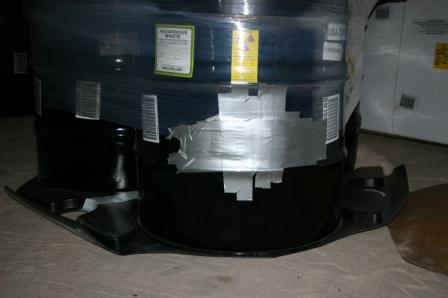 Punctured (and subsequently sealed) drum at WIPP
Punctured (and subsequently sealed) drum at WIPP
- Salt Disposal Investigations (2011 - 2012)
On August 11, 2011, the U.S. Department of Energy (DOE) provided a planned change notification to begin preparatory activities related to the Salt Disposal Investigations (SDI) project at the WIPP. Though SDI activities will start no sooner than October 1, 2011, DOE submitted early supporting documentation in support of this project. On November 17, 2011, the EPA issued an approval for the initial mining phase of the SDI project, based on responses provided by the DOE. The final design of the heater test portion of the SDI project (which will not commence for a number of years) has not yet been submitted; the Agency will review and issue a decision on the heater tests at a future date.
The primary objective of the SDI project is to provide thermal, structural, and hydro-geochemical data for high temperature (greater than 160 degrees Celsius) effects in bedded salt. Contingent on adequate funding, mining of the test area is projected to being in October 2011 and continue for approximately 80 weeks. Once all equipment and preliminary testing has concluded, the heating tests are scheduled to begin in 2015 and continue for two years, followed by a cool-down phase and post-test forensics to be completed in FY 2018. The results of these investigations will fill information gaps in the current knowledge of thermomechanical, hydrological, and chemical behavior of salt and wastes disposed in salt and form the technical foundation for design, operation, coupled process modeling, and performance assessment of future salt repositories for heat-generating nuclear waste.
The DOE has submitted results of their preliminary testing and analyses (based on previous EPA Unreviewed Safety Question [USQ] Determination guidance). The Department submits that the SDI will not have a significant impact on long-term performance of the disposal system, as demonstrated by a thermal analysis and an impact assessment. In addition, the DOE states that the SDI will not require modification to waste disposal processes and will have no significant impact on waste disposal operations.
On June 20, 2012, the DOE submitted revisions to the original SDI concept. These revisions added an additional component, and possible alternative to the SDI project entitled the Salt Defense Disposal Investigations (SDDI) project.
On November 17, 2011, the EPA issued an approval for the initial mining phase of the SDI project based on responses provided by the DOE. The final design of the heater test portion of the SDI project (which will not commence for a number of years) has not yet been submitted; the Agency will review and issue a decision on the heater tests at a future date.
- EPA-DOE Technical Meeting & Informal Stakeholder Meeting (October 2011)
The EPA and the DOE met in Albuquerque, NM, on October 18, 2011, to discuss various WIPP technical issues. In addition, select staff from the EPA, the DOE and the NMED met with stakeholders in Santa Fe, NM, on October 19, 2011
- Repository Reconfiguration (August 2011)
On August 30, 2011, the U.S. Department of Energy (DOE) provided a proposed planned change request that will relocate Panels 9 and 10 from the main north-south access drifts to south of the existing Panels 4 and 5 in the WIPP repository. DOE states that relocating these panels will enhance worker safety and reduce maintenance requirements by providing a more stable geotechnical environment.
The Department submitted a performance assessment (PA) for the proposed repository reconfiguration as part of their documentation package. The results of the PA show that the WIPP will remain in compliance with all containment requirements found in 40 CFR 191 and have only a minor effect on total normalized releases from the repository.
- Drum Accidentally Punctured in the WIPP Underground (2008)
On the morning of August 4, 2008, the DOE notified the EPA that during underground operations on August 3, 2008, WIPP staff noticed that a drum had a 1-2 inch gash in it. The DOE believes that the drum was punctured during emplacement activities. Initial tests conducted by DOE detected no releases in the area of the drum or in the radiation monitors at the WIPP. The Department of Energy has temporarily halted shipments to the WIPP.
Additional tests have been done (including the entire area around the payload stacks and breached drum) through August 5, 2008, and the DOE has still detected no radiation from the drum. The drum contains waste from a debris waste stream and the waste is in an inner plastic bag that apparently has not ruptured. The drum has been sealed and the DOE plans to have it overpacked underground. Waste shipments will continue to be suspended until final disposition of the drum is determined.
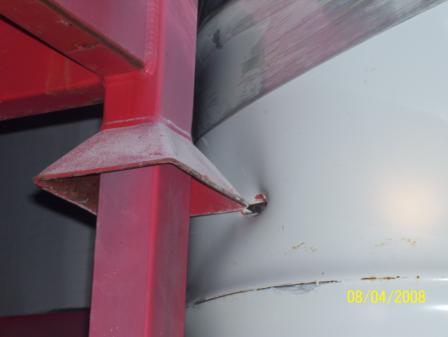 Punctured drum at WIPP
Punctured drum at WIPP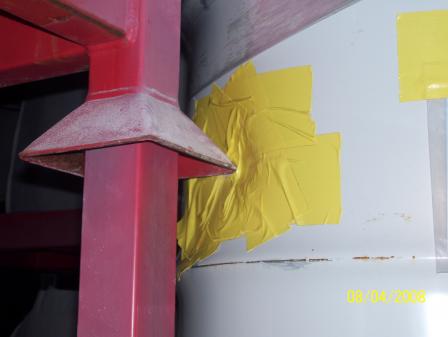 Sealed drum at WIPP
Sealed drum at WIPP
- Los Alamos National Laboratory TRU waste shipments suspension lifted (2008)
On June 6, 2008, the EPA was notified by the U.S. Department of Energy (DOE) that on May 20, 2008, the Central Characterization Program (CCP) at Los Alamos National Laboratory (LANL) shipped an improperly certified non-conformant (NCR) drum (# LAS817174) of contact-handled (CH) transuranic (TRU) waste containing prohibited liquids to the Waste Isolation Pilot Plant (WIPP) for disposal. According to the DOE notification, the drum was mistakenly added to a group of TRU waste drums, over packed in a standard waste box (SWB), and emplaced in the repository on May 28, 2008. As a result, the EPA and the DOE Carlsbad Field Office (CBFO) had mutually agreed to suspend shipments from LANL to the WIPP.
The EPA conducted an initial inspection at LANL on June 25, 2008. On July 29, 2008, the EPA conducted a follow-up inspection at LANL regarding the events that led to the emplacement at the WIPP of the non-conformant drum. These inspections by EPA staff included the following:
- Interviews of LANL and CCP staff.
- Review of DOE and CCP documentation, including the CCP root cause analysis and corrective actions.
- Observing the CCP data center database used to screen compliant drums.
- Visiting LANL’s transuranic (TRU) waste storage/staging area, Dome 49, where both NCRed & non-NCRed TRU drums and other drums in the waste characterization process are stored, moved around, and sent for characterization, as instructed by LANL-CCP.
Based on the documentation provided by the DOE and the EPA’s review of the events leading to the incorrect shipment of the drum from LANL, the Agency concurred with CBFO’s decision to resume shipment of LANL’s CH TRU waste except for most containers from the MIN-03 and CIN-02 solid waste streams on July 29, 2008. These waste streams could be shipped after the EPA evaluates the CCP data center database used by LANL-CCP for screening compliant drums.
